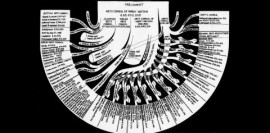
Creative Scotland consultation
Help shape Creative Scotland’s future plans.

Help shape Creative Scotland’s future plans.
UK survey raises issues of social value and economic survival. Frances Lord reports.
Whilst public art is distinctly ‘out of favour’ with Arts Council England cutting agencies as part of making savings, it’s interesting to see Creative Scotland taking a rather different tack.
As an important part of platforming the debate around arts funding across the UK, with kind permission we re-publish the editorial introduction to “Language is never neutral” from Variant‘s issue 42.
In October, Eden District Council announced a cut of 70% to Eden Arts by 2014.
The key finding of this study reveals that shockingly few individual artists apply for funding in their own right, and even fewer are successful. What this means is that there is little direct funding being given to artists to pursue and develop their own projects, under their own control – under 20% of available funding for the visual arts in England, 14% for Northern Ireland and around 18% for Scotland and Wales in 2009-2010.

Is there enough funding going to individual artists and are the application processes user-friendly? These were questions a-n set out to answer in the fourth issue of what was then Artists Newsletter in 1980. Now, thirty one years later, we asked Dany Louise to do this research again, examining the current state of play for grants to individual artists as offered by Arts Council England, Arts Council of Northern Ireland, Arts Council of Wales and Creative Scotland – including comparators of volumes of artists applying and success rates – and to ascertain whether a “fair share” has been getting into the hands of artists to develop their practice.
As part of its ongoing mission to support contemporary visual arts practice, this month a-n publishes two reports in the feature ‘Artists, arts policy and funding’.

Launched in March, Creative Scotland’s first corporate plan presented an ambitious vision for the nation’s arts, culture and creative industries. This is backed by core Treasury financing of £35.5m with £14.5m of Scottish Government funds for specific initiatives, unspent reserves from the interim between Scottish Arts Council/Scottish Screen and Creative Scotland, some lottery funding back after diversion to the Olympics and reduced overheads due the merger that included a 30% staff cut.
We are heading for straitened times. The UK’s government departments have been ordered by the Treasury to plan for unprecedented cuts of 40% in their budgets as the coalition widens the scope of its four-year austerity drive.
A recent awardee of Arts Council England’s Grants For The Arts program, I am participating in a 2 month residency investigating post-colonialism and the uncanny body in Saint Louis, Senegal. With additional support from WAAW Centre for Art, this blog […]
The forth and final Creative Scotland dialogue event was held at the impressively refurbished Briggait building on the banks of the River Clyde, Glasgow.
A round-up of recent shortlists, winners and awards.
It’s just over a year ago now that a letter was signed by over 440 arts practitioners from all over Scotland, voicing concerns at the proposed creation of Creative Scotland, an amalgamation of the Scottish Arts Council and Scottish Screen, with an expanded remit covering the creative industries and other commercial activity that would previously have been covered by Scottish Enterprise.
Hans Abbing’s provocation on the Creative Scotland debate site posits that “general subsidies for artists should gradually be abolished…”
The Scottish Artists Union is the leading representative body for visual and applied artists north of the border. We continue to monitor the formation of the new agency Creative Scotland, set to replace the Scottish Arts Council and Scottish Screen […]
The Arts Council of Great Britain was established in 1946. After cutbacks under Conservative governments in the 1980s the organisation was devolved between England, Scotland and Wales in 1994. Following a confusing series of twists and turns over cultural policy […]
It is understandable that the development of Creative Scotland has been perceived by many cultural practitioners as an attack on the arts themselves. An initial response from some practitioners has been to defend the arts through the various well-known claims of the value of arts to the economy.
The recent flurry of arts consultations across the UK has raised the question of artists’ representation on decision-making fora. Here we report on developments surrounding AIR and the proposed Creative Scotland merger, and the willingness (or otherwise) of others to listen to artists’ opinions.
The latest arts policy and funding developments.
Changes announced in November to the draft bill to establish Creative Scotland means that like its predecessors Scottish Arts Council and Scottish Screen, it will enjoy complete autonomy when providing financial and other support to those working in the creative […]
The Royal Society of Edinburgh (RSE) response to the Scottish Funding Council’s request for advice on Scotland’s position in research relevant to the creative industries.
New appointments and farewells.
Scotland’s largest gathering of artists, arts organisations and delegates from the cultural sector will converge on Edinburgh next year for a three-day cultural summit.
Notions of locating Creative Scotland – the new body arising from the merger of Scottish Arts Council with Scottish Screen – outwith Edinburgh is upsetting both the city council and those arts professionals who may be looking to Creative Scotland for their future careers.


